Sensitivity Enhancement of FBG-Based Strain Sensor
Abstract
:1. Introduction
2. Sensitization Model of the Sensor
2.1. The Principle of Strain Sensing of FBG
2.2. Structure and Strain Amplification Mechanism
3. Simulation Analysis
3.1. Static Analysis
- The lever structure is simplified as a rod structure in the theoretical calculation.
- The theoretical calculation parameters are based on central sizes of the simplified rods.
- The characteristics of the adhesive are not considered in the theoretical calculations, while the adhesive thickness between the substrate of the developed FBG strain sensor and the specimen reduces the strain transform coefficient in the FEM analysis.
3.2. Dynamic Characteristics Analysis
4. Experimental Study of the Sensing Properties
4.1. Static Properties
4.2. Dynamic Properties
5. Conclusions
Author Contributions
Acknowledgments
Conflicts of Interest
References
- Farrar, C.R.; Worden, K. An introduction to structural health monitoring. Philos. Trans. R. Soc. A 2007, 365, 303–315. [Google Scholar] [CrossRef] [PubMed]
- Bakht, B.; Mufti, A. Structural health monitoring. In Bridges; Springer: Cham, Switzerland; New York, NY, USA, 2015; pp. 307–354. [Google Scholar]
- Zhou, Z.; Gui, L.; Tan, Y.; Liu, M.; Liu, Y.; Li, R. Actualities and development of heavy-duty CNC machine tool thermal error monitoring technology. Chin. J. Mech. Eng. 2017, 30, 1262–1281. [Google Scholar] [CrossRef]
- Zhou, Z.; Liu, Q.; Ai, Q.; Xu, C. Intelligent monitoring and diagnosis for modern mechanical equipment based on the integration of embedded technology and FBGS technology. Measurement 2011, 44, 1499–1511. [Google Scholar] [CrossRef]
- Villalba, S.; Casas, J.R. Application of optical fiber distributed sensing to health monitoring of concrete structures. Mech. Syst. Signal Process. 2013, 39, 441–451. [Google Scholar] [CrossRef]
- Guo, H.; Xiao, G.; Mrad, N.; Yao, J. Fiber optic sensors for structural health monitoring of air platforms. Sensors 2011, 11, 3687–3705. [Google Scholar] [CrossRef] [PubMed]
- Majumde, M.; Gangopadhyay, T.K.; Chakraborty, A.K.; Dasgupta, K.; Bhattacharya, D.K. Fibre Bragg gratings in structural health monitoring-present status and applications. Sens. Actuators A Phys. 2008, 147, 150–164. [Google Scholar] [CrossRef]
- Glavind, L.; Olesen, I.S.; Skipper, B.F.; Kristensen, M.V. Fiber-optical grating sensors for wind turbine blades: A review. Opt. Eng. 2013, 52, 030901. [Google Scholar] [CrossRef]
- Kang, D.; Chung, W. Integrated monitoring scheme for a maglev guideway using multiplexed FBG sensor arrays. NDT E Int. 2009, 42, 260–266. [Google Scholar] [CrossRef]
- Lawson, N.J.; Correia, R.; James, S.W.; Partridge, M.; Staines, S.E.; Gautrey, J.E.; Garry, K.P.; Holt, J.C.; Tatam, R.P. Development and application of optical fibre strain and pressure sensors for in-flight measurements. Meas. Sci. Technol. 2016, 27, 104001. [Google Scholar] [CrossRef]
- Li, W.; Xu, C.; Ho, S.C.M.; Wang, B.; Song, G. Monitoring concrete deterioration due to reinforcement corrosion by integrating acoustic emission and fbg strain measurements. Sensors 2017, 17, 657. [Google Scholar] [CrossRef] [PubMed]
- Huang, J.; Zhou, Z.; Zhang, L.; Chen, J.; Ji, C.; Pham, D.T. Strain modal analysis of small and light pipes using distributed fibre bragg grating sensors. Sensors 2016, 16, 1583. [Google Scholar] [CrossRef] [PubMed]
- Li, R.; Tan, Y.; Hong, L.; Zhou, Z.; Li, T.; Cai, L. A temperature-independent force transducer using one optical fiber with multiple Bragg gratings. IEICE Electron. Express 2016, 13. [Google Scholar] [CrossRef]
- Xiong, L.; Jiang, G.; Guo, Y.; Liu, H. A three-dimensional fiber Bragg grating force sensor for robot. IEEE Sens. J. 2018, 18, 3632–3639. [Google Scholar] [CrossRef]
- Niu, H.; Zhang, X.; Hou, C. An approach for the dynamic measurement of ring gear strains of planetary gearboxes using fiber bragg grating. Sensors 2017, 17, 2872. [Google Scholar] [CrossRef] [PubMed]
- Mieloszyk, M.; Ostachowicz, W. An application of structural health monitoring system based on FBG sensors to offshore wind turbine support structure model. Mar. Struct. 2017, 51, 65–86. [Google Scholar] [CrossRef]
- Fang, L.; Chen, T.; Li, R.; Liu, S. Application of embedded fiber Bragg grating (FBG) sensors in monitoring health to 3D printing structures. IEEE Sens. J. 2016, 16, 6604–6610. [Google Scholar] [CrossRef]
- Pereira, G.; Frias, C.; Faria, H.; Frazao, O.; Marques, A.T. Study of strain-transfer of FBG sensors embedded in unidirectional composites. Polym. Test. 2013, 32, 1006–1010. [Google Scholar] [CrossRef]
- Zhou, Z.; Tan, Y.; Liu, M.; Yang, W.; Li, Z. Actualities and development on dynamic monitoring and diagnosis with distributed fiber Bragg grating in mechanical systems. J. Mech. Eng. 2013, 49, 55–69. [Google Scholar] [CrossRef]
- Ren, L.; Chen, J.; Li, H.; Song, G.; Ji, X. Design and application of a fiber Bragg grating strain sensor with enhanced sensitivity in the small-scale dam mode. Smart Mater. Struct. 2009, 18, 035015. [Google Scholar] [CrossRef]
- Li, L.; Zhang, D.; Liu, H.; Guo, Y.; Zhu, F. Design of an enhanced sensitivity FBG strain sensor and application in highway-bridge engineering. Photonic Sens. 2014, 4, 162–167. [Google Scholar] [CrossRef]
- Zhang, L.; Liu, Y.; Gao, X.; Xia, Z. High temperature strain sensor based on a fiber Bragg grating and rhombus metal structure. Appl. Opt. 2015, 54, E109–E112. [Google Scholar] [CrossRef] [PubMed]
- Guo, Y.; Kong, J.; Liu, H.; Hu, D.; Qin, L. Design and investigation of a reusable surface-mounted optical fiber Bragg grating strain sensor. IEEE Sens. J. 2016, 16, 8456–8462. [Google Scholar] [CrossRef]
- Nawrot, U.; Geernaert, T.; Pauw, B.D.; Anastasopoulos, D.; Reynders, E.; Roeck, G.D.; Berghmans, F. Development of a mechanical strain amplifying transducer with Bragg grating sensor for low-amplitude strain sensing. Smart Mater. Struct. 2017, 26, 075006. [Google Scholar] [CrossRef]
- Nawrot, U.; Geernaert, T.; Pauw, B.D.; Anastasopoulos, D.; Reynders, E.; Roeck, G.D.; Berghmans, F. Mechanical strain-amplifying transducer for fiber Bragg grating sensors with applications in structural health monitoring. In Proceedings of the 25th International Conference on Optical Fiber Sensors, Jeju, Korea, 24–28 April 2017. [Google Scholar]
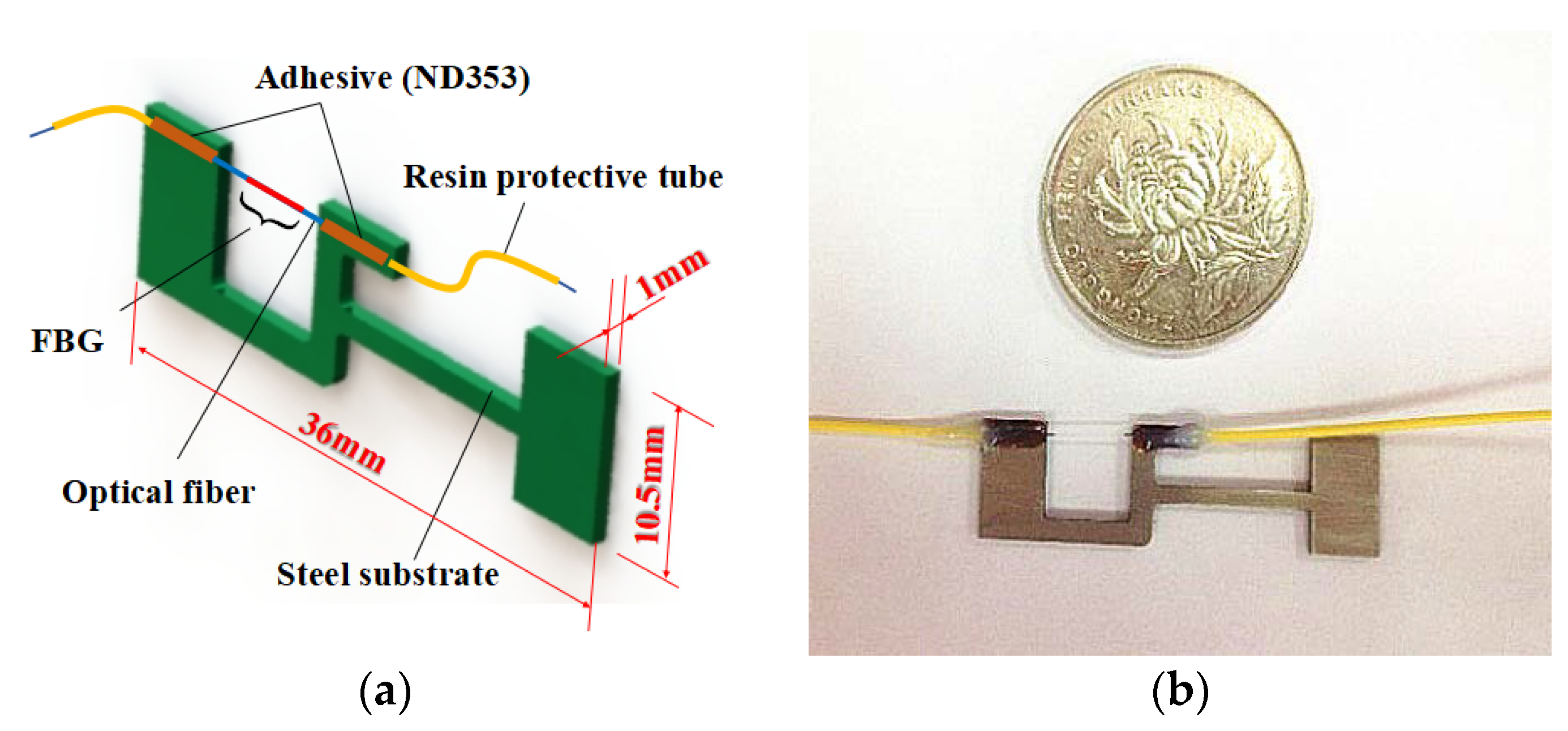



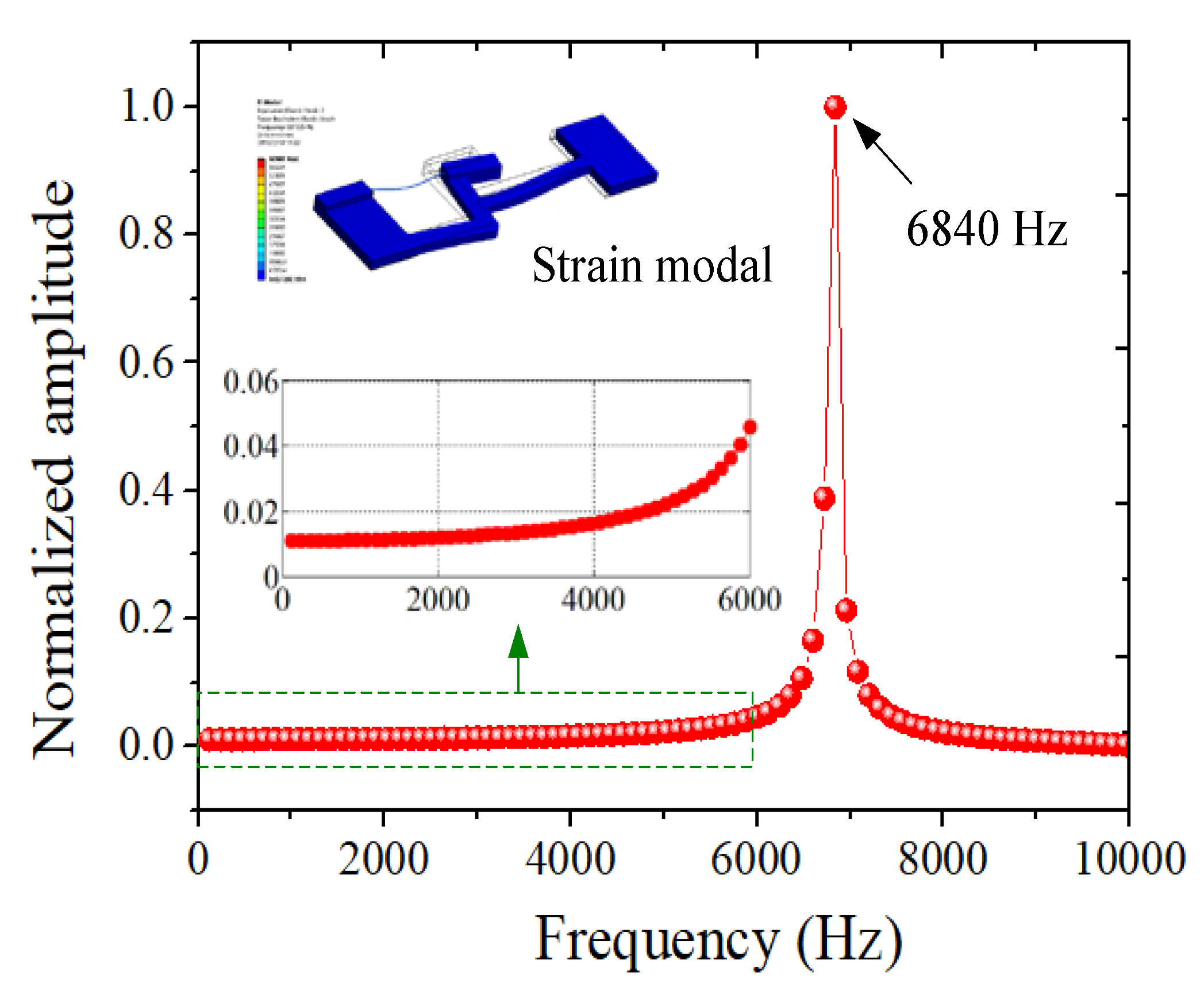
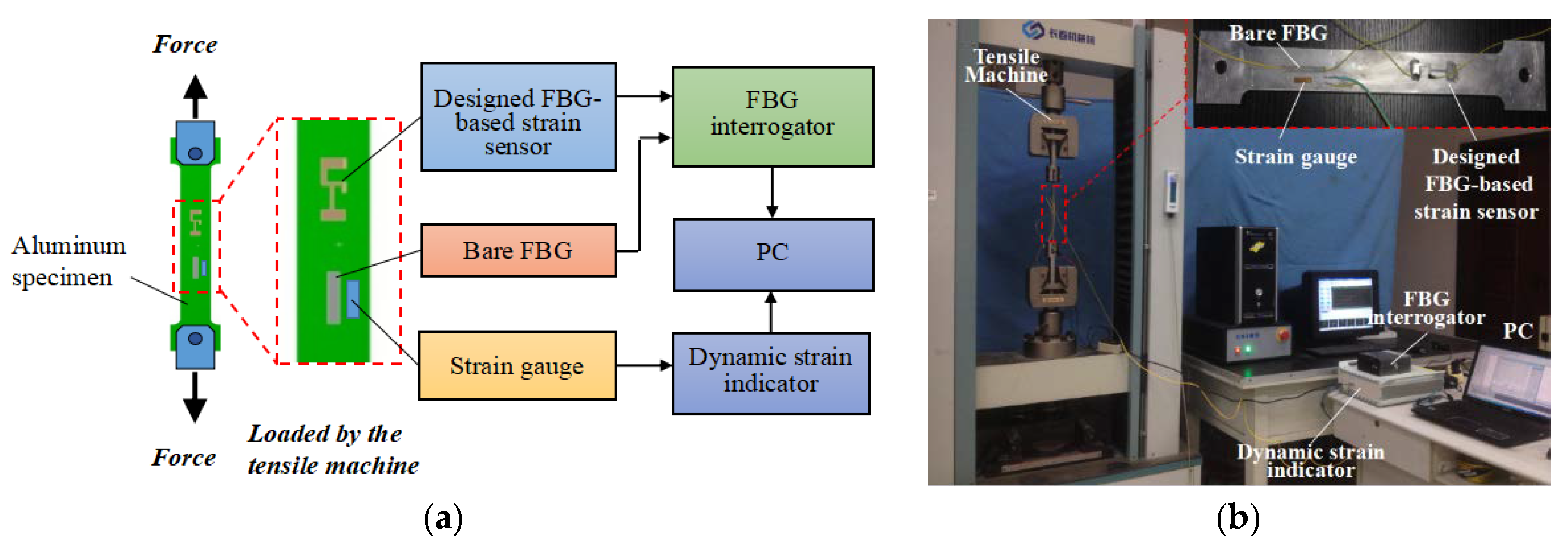
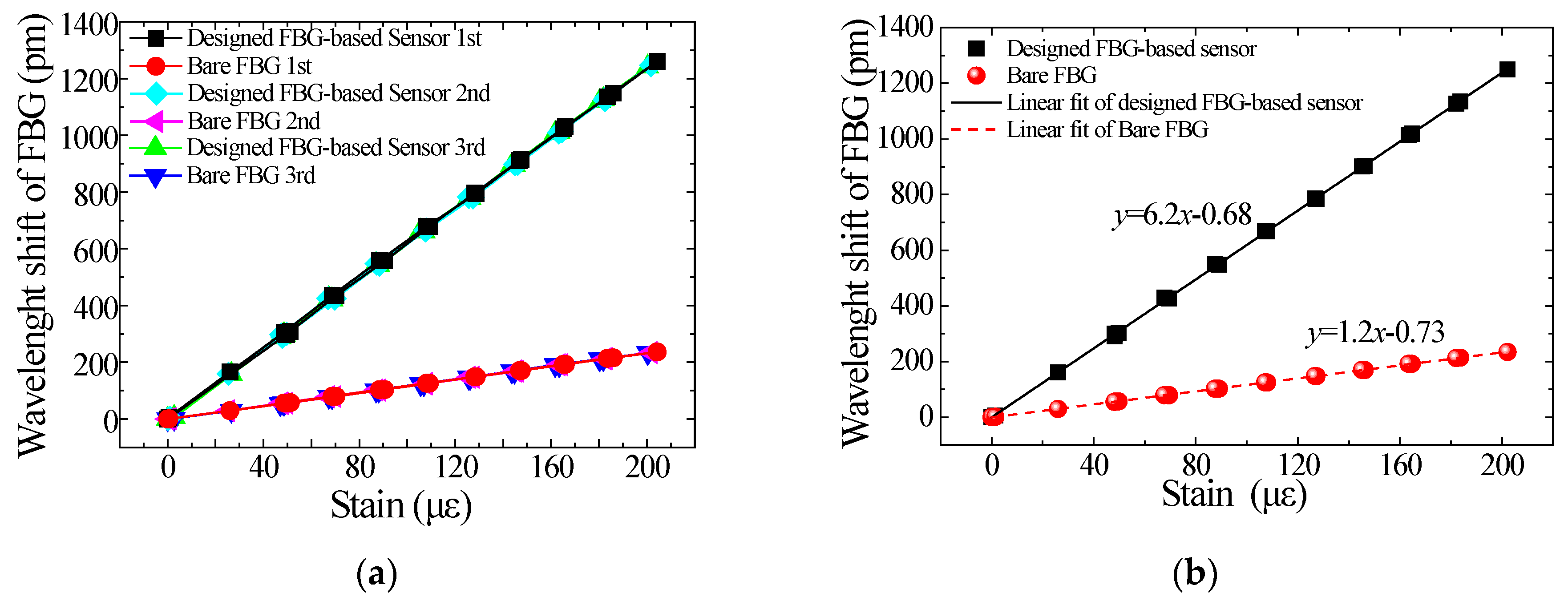
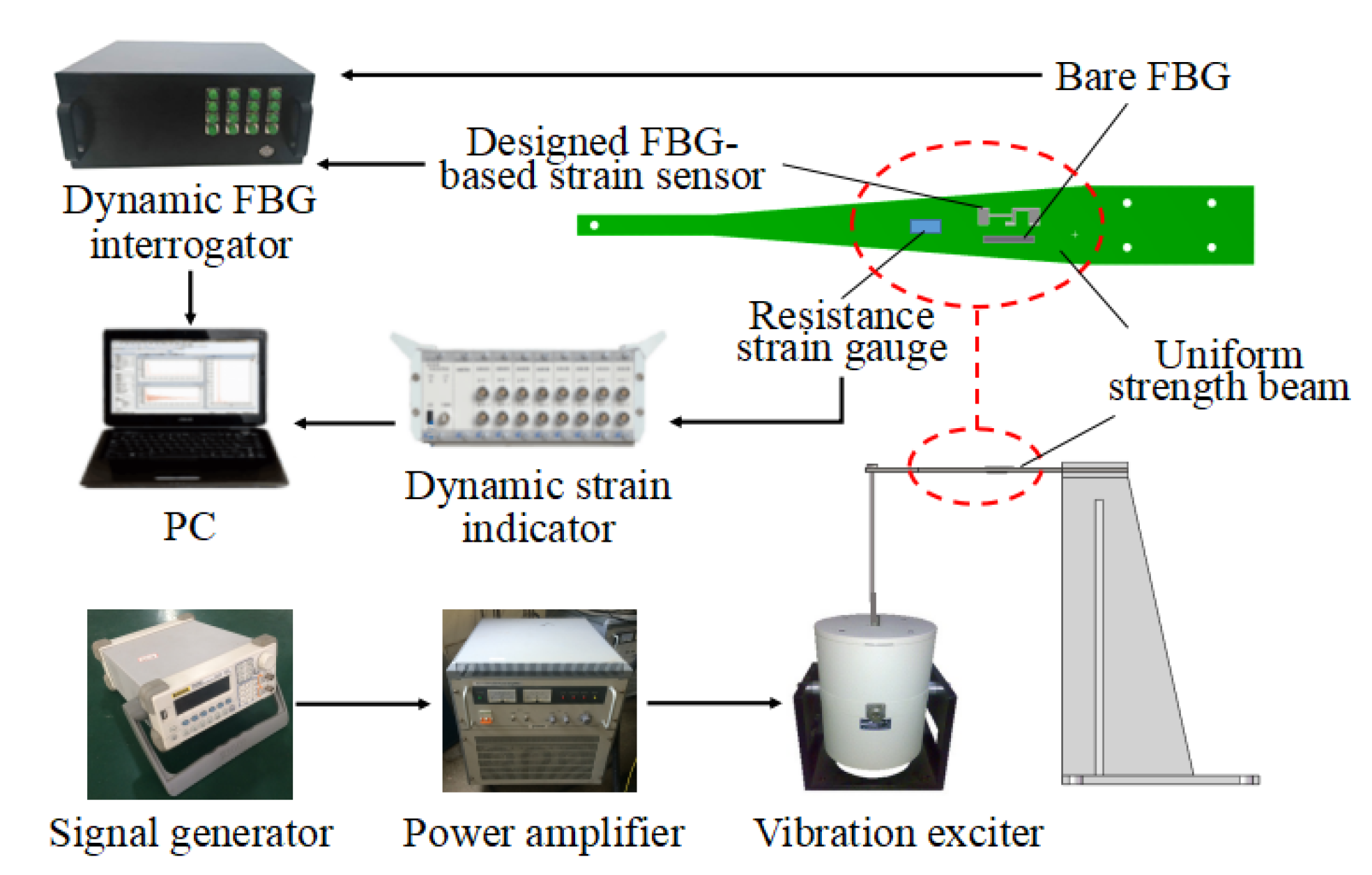
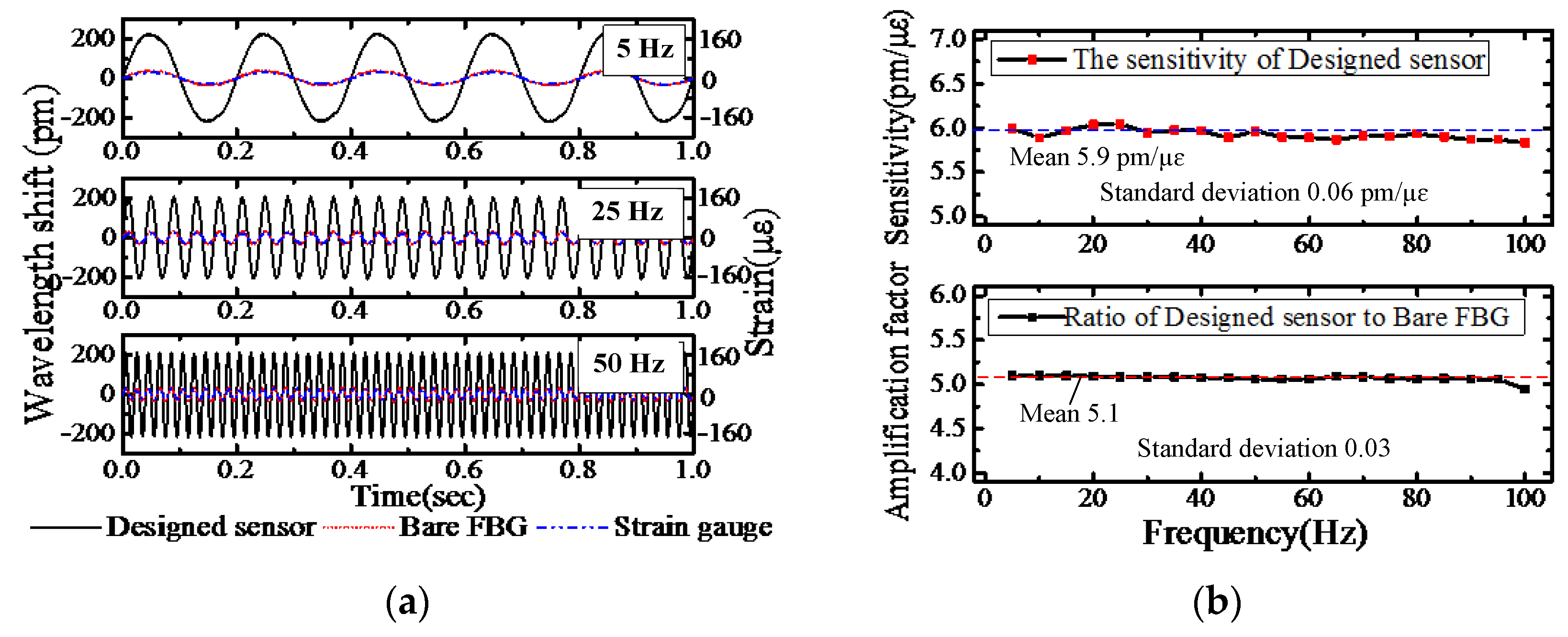
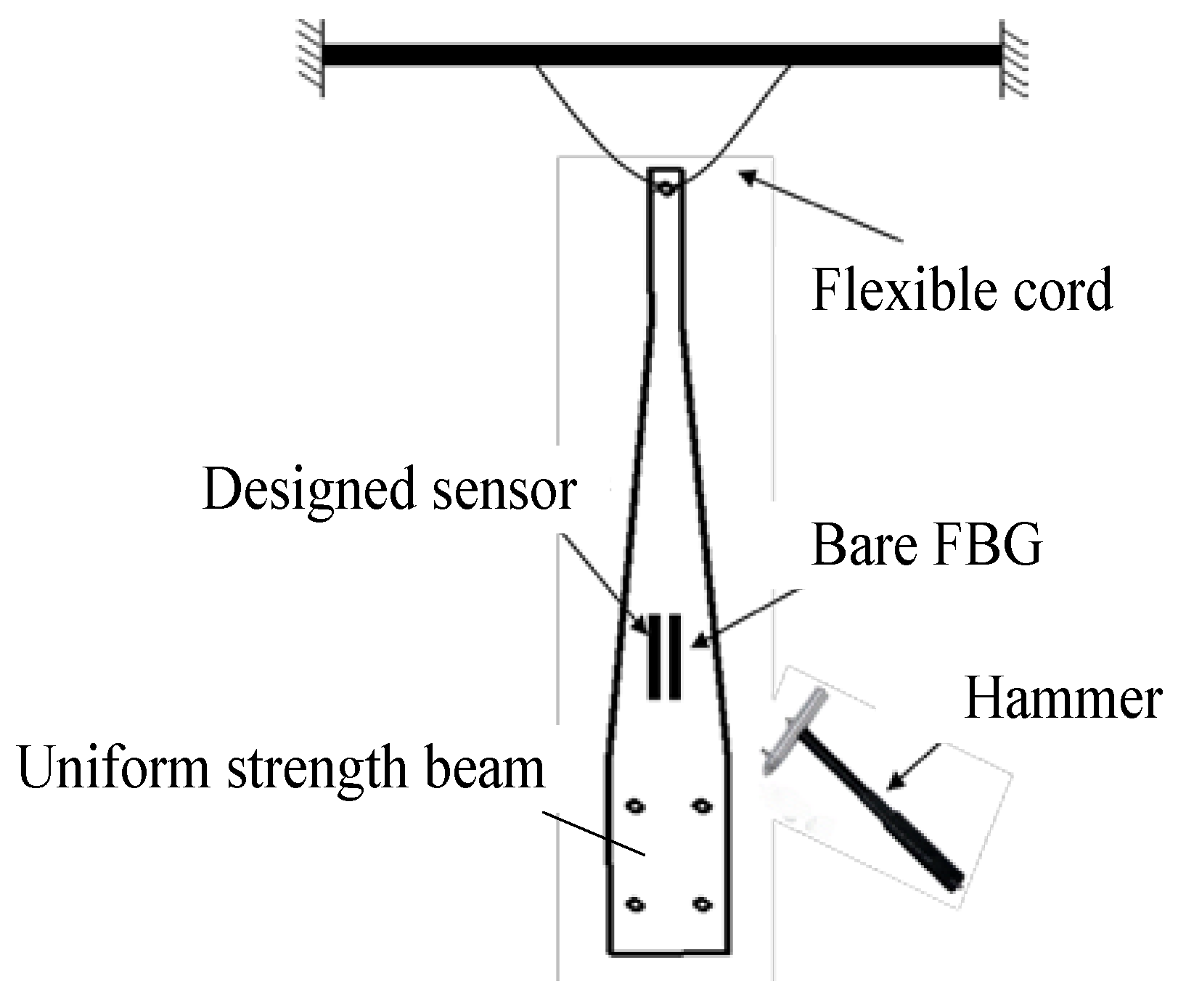
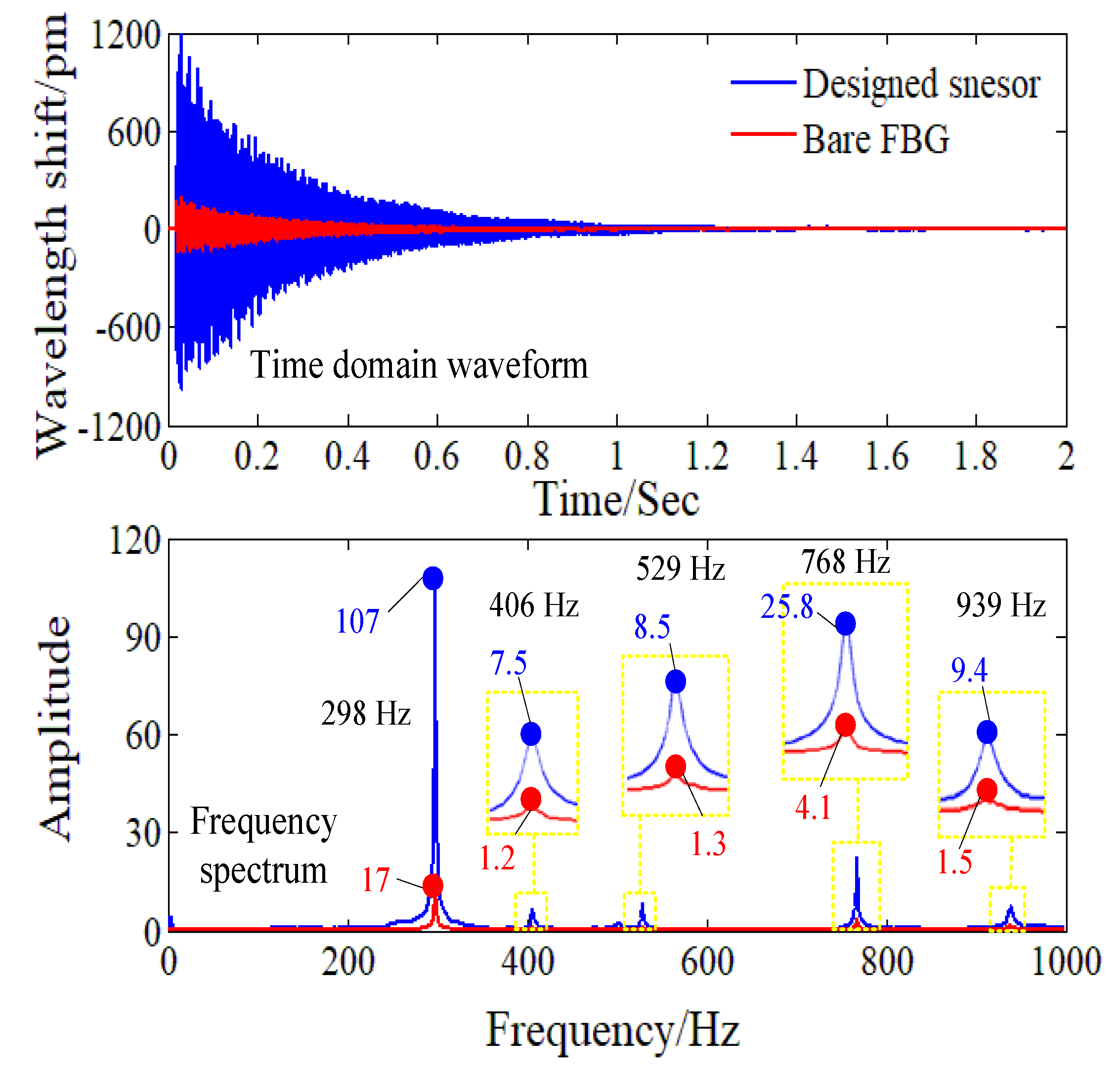
| Structure | Material | Elastic Modulus | Poisson Ratio |
|---|---|---|---|
| Substrate | Stainless steel 304 | E = 200 Gpa | ν = 0.3 |
| FBG | Silica | EFBG = 74.52 Gpa | νFBG = 0.17 |
| Adhesive | Epoxy resin | Ea = 3.0 Gpa | νa = 0.38 |
| Parameters | Values | Parameters | Values |
|---|---|---|---|
| d1 | 24 mm | S1 | 1.5 mm2 |
| d2 | 15 mm | S2 | 2 mm2 |
| d3 | 9 mm | S3 | 2 mm2 |
| d4 | 8.5 mm | S4 | 0.012272 mm2 |
| d5 | 5 mm | I2 | 2/3 mm4 |
| d6 | 3.5 mm | I3 | 2/3 mm4 |
© 2018 by the authors. Licensee MDPI, Basel, Switzerland. This article is an open access article distributed under the terms and conditions of the Creative Commons Attribution (CC BY) license (http://creativecommons.org/licenses/by/4.0/).
Share and Cite
Li, R.; Chen, Y.; Tan, Y.; Zhou, Z.; Li, T.; Mao, J. Sensitivity Enhancement of FBG-Based Strain Sensor. Sensors 2018, 18, 1607. https://doi.org/10.3390/s18051607
Li R, Chen Y, Tan Y, Zhou Z, Li T, Mao J. Sensitivity Enhancement of FBG-Based Strain Sensor. Sensors. 2018; 18(5):1607. https://doi.org/10.3390/s18051607
Chicago/Turabian StyleLi, Ruiya, Yiyang Chen, Yuegang Tan, Zude Zhou, Tianliang Li, and Jian Mao. 2018. "Sensitivity Enhancement of FBG-Based Strain Sensor" Sensors 18, no. 5: 1607. https://doi.org/10.3390/s18051607





